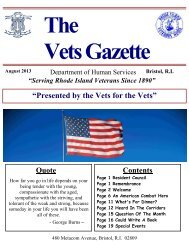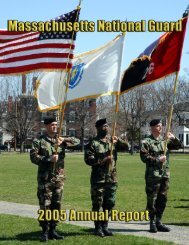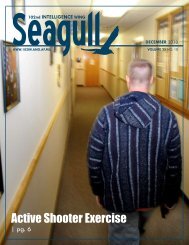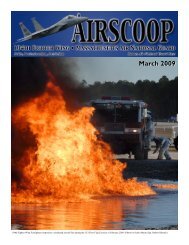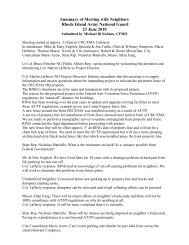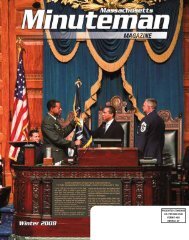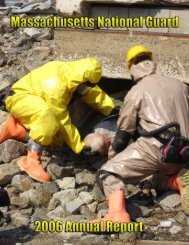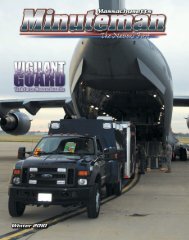CAPITAL GUARDIAN / Fall 2008 - STATES - The National Guard
CAPITAL GUARDIAN / Fall 2008 - STATES - The National Guard
CAPITAL GUARDIAN / Fall 2008 - STATES - The National Guard
You also want an ePaper? Increase the reach of your titles
YUMPU automatically turns print PDFs into web optimized ePapers that Google loves.
are not going to shoot at you.”<br />
Air Force Maj. Glenn Burns,<br />
Operation Kerkesner course<br />
director, said the exercise<br />
teaches not only basic survival<br />
skills, but also leadership<br />
principles. “This is not a test of<br />
infantry skills, and we are not<br />
trying to develop them as<br />
infantry officers,” Burns said.<br />
“But as we teach them the<br />
basics, what we expect to challenge<br />
them with is leadership.”<br />
Fourth-year students were<br />
facing those leadership<br />
challenges as they treated<br />
patients while rotating through<br />
a variety of roles they’ll play as<br />
medical officers, from litter<br />
bearers to logistics officers to<br />
unit commanders.<br />
<strong>The</strong> exercise reinforces the<br />
fact that doctors are just<br />
one part of a vast medical care<br />
network, Sharp said, while<br />
underscoring their broad<br />
responsibilities as military<br />
medical officers.<br />
“Being a medical officer isn’t just being a doctor,” he<br />
said. “It’s about leadership. It’s about planning and organization.<br />
It’s about communication. It’s about situational<br />
awareness. It’s about learning to prioritize because you<br />
never have enough resources or people, and you never have<br />
enough evacuation (capability).”<br />
Navy Ensign Art Ambrosio got a taste of what it means<br />
to balance those challenges when casualties started arriving<br />
as he was serving as commander, overseeing the assembly<br />
of the expeditionary medical support unit. A fourth-year<br />
student, Ambrosio had to resist the urge to drop everything<br />
and rush to the patients’ needs rather than allowing his<br />
staff to do that. “As a medical person, when you see<br />
someone hurt, you want to run, and you want to play<br />
doctor,” he said.<br />
“But as the commander, you need to focus on what<br />
those responsibilities are,” he said. “Your job is to keep the<br />
whole machine running: the medical, the transportation,<br />
the security, the communications, the logistics. You have to<br />
manage people, but do it without micromanaging.”<br />
For some of the students, the exercises offer a return to<br />
principles they learned during prior service in the Army,<br />
Navy, Air Force and Marine Corps, but with a new focus.<br />
Among them is Army 2nd Lt. Gabriel Pavey, who spent<br />
12 years in the Marine Corps before enrolling in the<br />
Photo: Air Force Tech. Sgt. Andre Nicholson<br />
Air Force Staff Sgt. Lacy Johnson, a staff member at the Uniformed Services<br />
University of the Health Sciences, applies “moulage” to simulate a combat<br />
wound on Army 2nd Lt. Dan Coughlin, a first-year medical student.<br />
Uniformed Services University. Pavey was a Marine staff<br />
sergeant working in the Pentagon on Sept. 11, 2001, and<br />
remembers the frustration of not being much help to the<br />
medics scurrying to help the wounded. He said it led to a<br />
major life decision.<br />
Now an Army second lieutenant about to enter his<br />
second year of medical school, Pavey said he’s ready for the<br />
rigors of field medicine in a combat environment. “It’s my<br />
brothers and sisters (in the force) who really do the hard<br />
part,” he said. “We’re here to support them. <strong>The</strong> folks here<br />
all have the same call to duty.”<br />
Army 2nd Lt. Barrett Campbell said the training he’s<br />
receiving at the Uniformed Services University is providing<br />
a great foundation for what he hopes will be a 20-year<br />
career as a military medical officer.<br />
“I want to be a military doctor first and foremost, and<br />
this is the place to prepare for that,” he said. “I chose this<br />
school because of the military medical aspect. I wanted to<br />
be in a program that trained me for that, and that's what<br />
I’m getting here.”<br />
Robins said the exercise reinforces the connection she<br />
feels to her fellow Uniformed Services University students,<br />
but especially to the servicemembers she will treat as a<br />
Navy doctor. “We have a like-mindedness,” she said. “<strong>The</strong>y<br />
are taking care of me, and I am taking care of them. <strong>The</strong>y<br />
are amazing people, and they deserve great care.” ✯<br />
<strong>Fall</strong> <strong>2008</strong> / <strong>CAPITAL</strong> <strong>GUARDIAN</strong> • 15



